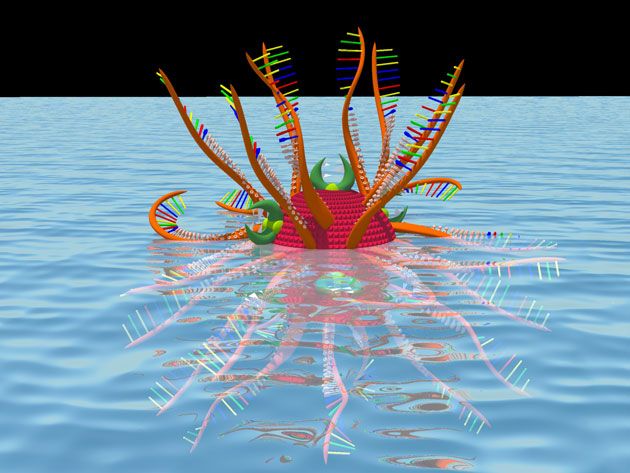BY: DEXTER JOHNSON
Researchers at the University of Florida (UF) have developed a nanoparticle that has shown 100 percent effectiveness in eradicating the hepatitis C virus in laboratory testing.
 The nanoparticle, dubbed a nanozyme, consists of a backbone made from gold nanoparticles and a surface with two biological components. One biological component is an enzyme that attacks and destroys the mRNA, which provides the recipe for duplicating the protein that causes the disease. The other biological part is the navigator, if you will. It is a DNA oligonucleotide that identifies the disease-related protein and sends the enzyme on course to destroy it.
The nanoparticle, dubbed a nanozyme, consists of a backbone made from gold nanoparticles and a surface with two biological components. One biological component is an enzyme that attacks and destroys the mRNA, which provides the recipe for duplicating the protein that causes the disease. The other biological part is the navigator, if you will. It is a DNA oligonucleotide that identifies the disease-related protein and sends the enzyme on course to destroy it.Y. Charles Cao, a UF associate professor of chemistry, and Dr. Chen Liu, a professor of pathology at the UF College of Medicine published their research online this week in the Proceedings of the National Academy of Sciences ("Nanoparticle-based artificial RNA silencing machinery for antiviral therapy").
The basis of the work is mimicking the biological process of RNA interference, which researchers in the past have used effectively in the laboratory for treating HIV. In the UF research the nanoparticle mimics the function of RNA-induced silencing complex (RISC), which mediates the RNA interference process.
Current hepatitis C treatments do attack the replication process of the virus but they are not entirely effective and only help about 50 percent of the patients treated with them. Cao and Liu along with their team wanted to see if they could improve upon that percentage. The researchers claim that their treatment (in cell culture and mice) led to a near 100 percent eradication of the hepatitis C virus without bringing on any side effects caused by the immune system attacking the treatment.
Of course, this is a long way from becoming a treatment anytime soon. A major caveat is that the use of nanotreatments for the targeting and destroying of abnormal cells like cancer cells is always problematic since those cells are “still us” as George Whitesides noted some time back. It’s always a bit of a tricky business to make sure that nanoparticles are targeting those biological processes within us that we want stopped and not the ones we want to keep.
Further complicating this particular line of research is some of the terminology that is part of the press release. They have decided to use the term “nanorobots” to describe the nanoparticles, apparently because that can really excite the general public about what might otherwise be a fairly niche story. That’s fine, I suppose. Whatever manages to get the public interested in what is genuinely ground breaking research. The problem is that it creates confusion in some terribly misguided people who are convinced that we are about to be overrun by ‘nanobots’ that will render the planet into nothing but “gray goo”. Can’t we just retire the term “nano robots” for the sake of human life?
Fonte: NanoClast
